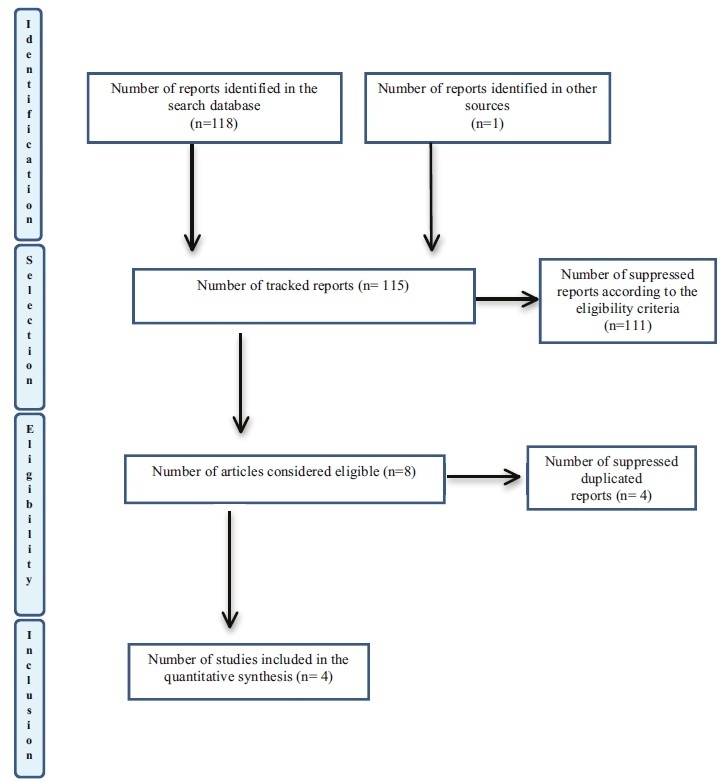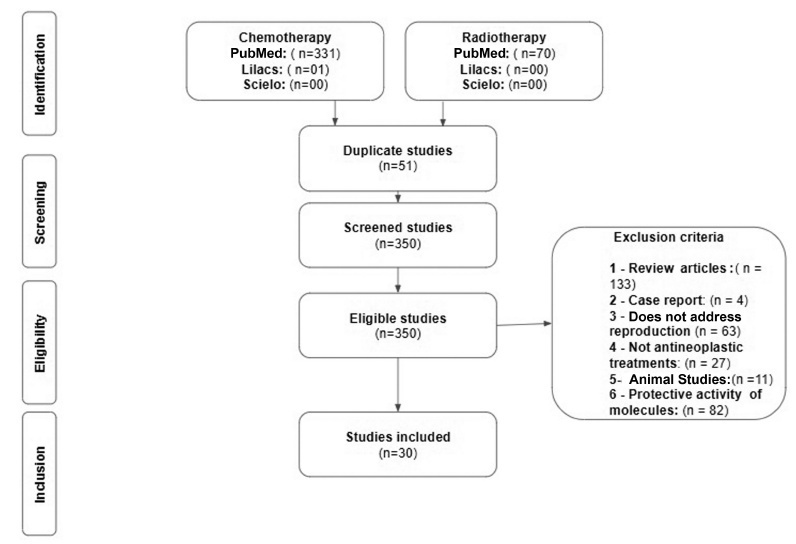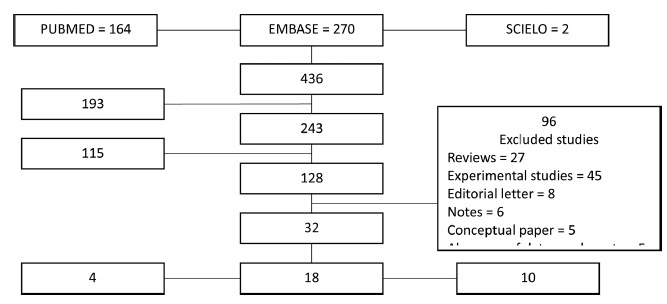Summary
. 2020;42(10):659-668
To identify the most effective procedures recommended for the prevention of preeclampsia.
A systematic review was performed in the following databases: Pubmed/MEDLINE, CINAHL, Web of Science, Cochrane and LILACS via the Virtual Health Library (VHL). A manual search was also performed to find additional references. The risk of bias, the quality of the evidence, and the classification of the strength of the recommendations were evaluated using the Grading of Recommendations, Assessment, Development and Evaluations (GRADE) approach.
In the initial search in the databases, the total number of articles retrieved was 351, and 2 were retrieved through the manual search; after duplicate articles were removed, 333 citations remained. After a thorough review of the titles and abstracts, 315 references were excluded. Accordingly, 18 articles were maintained for selection of the complete text (phase 2). This process led to the exclusion of 6 studies. In total, 12 articles were selected for data extraction and qualitative synthesis.
The articles selected for the study were analyzed, and we inserted the synthesis of the evidence in the online software GRADEpro Guideline Development Tool (GDT) (McMaster University and Evidence Prime Inc. All right reserved. McMaster University, Hamilton, Ontário, Canada); thus, it was possible to develop a table of evidence, with the quality of the evidence and the classification of the strength of the recommendations.
In total, seven studies recommended the individual use of aspirin, or aspirin combined with calcium, heparin or dipyridamole. The use of calcium alone or in combination with phytonutrients was also highlighted. All of the studies were with women at a high risk of developing preeclampsia.
According to the studies evaluated, the administration of aspirin is still the best procedure to be used in the clinical practice to prevent preeclampsia.

Summary
. 2020;42(11):752-758
To identify whether the effects of thyroid disease during pregnancy and lactation affect the nutritional composition of human milk.
Systematic review of the scientific literature using the Medical Literature Analysis and Retrieval System Online/MedLine databases to evaluate the association of thyroid diseases during pregnancy and lactation with the nutritional composition of human milk. There was no delimitation by period or by language, and the searches were completed in March 2019. The following descriptors were applied: human milk AND thyroid AND composition, using the preferred reporting items for systematic reviews and meta-analyses (PRISMA) protocol for data search, selection, and extraction. The flowchart proposed for bibliographic search resulted in 12 articles and, of these, four were selected.
The articles elected for this review were published between 1976 and 2018. Two studies found significant differences in the nutritional composition of mothers' milk with hypothyroidism or overweight compared with the milk of those without hypothyroidism. Studies have shown that the presence of the disease led to changes in the nutritional composition of human milk, especially a higher concentration of human milk fat.
It is extremely important that these women have continuous nutritional follow-up to minimize the impact of these morbidities on the nutritional composition of human milk.

Summary
. 2020;42(11):759-768
To analyze the long-term effects of antineoplastic treatments on patient fertility.
The studies were selected through the New PubMed, Scielo and Lilacs databases along with references used for the creation of the present work. For the selection of studies, articles published between the periods from January 1, 2015 to April 6, 2020 in the English, Portuguese and Spanish languages were used. As inclusion criteria: cohort studies and studies conducted in vitro. As exclusion criteria: review articles, reported cases, studies that do not address thematic reproduction, studies that do not address the cancer theme, articles that used animals, articles that address the preservation of fertility and articles in duplicate in the bases.
The collected data included: age of the patient at the beginning of treatment, type of neoplasm, type of antineoplastic treatment, chemotherapy used, radiotherapy dosage, radiotherapy site, effect of antineoplastic agents on fertility and number of patients in the study.
Thirty studies were evaluated, antineoplastic chemotherapy agents and radiotherapy modulate serum hormone levels, reduces germ cell quantities and correlated with an increase in sterility rates. The effects mentioned occur in patients in the prepubertal and postpubertal age.
Antineoplastic treatments have cytotoxic effects on the germ cells leading to hormonal modulation, and pubertal status does not interfere with the cytotoxic action of therapies.

Summary
. 2020;42(9):562-568
The present comprehensive review aims to show the full extent of what is known to date and provide a more thorough view on the effects of SARS-CoV2 in pregnancy.
Between March 29 and May, 2020, the words COVID-19, SARS-CoV2, COVID- 19 and pregnancy, SARS-CoV2 and pregnancy, and SARS and pregnancy were searched in the PubMed and Google Scholar databases; the guidelines from well-known societies and institutions (Royal College of Obstetricians and Gynaecologists [RCOG], American College of Obstetricians and Gynecologists [ACOG], International Society of Ultrasound in Obstetrics & Gynecology [ISUOG], Centers for Disease Control and Prevention [CDC], International Federation of Gynecology and Obstetrics [FIGO]) were also included.
The COVID-19 outbreak resulted in a pandemic with > 3.3 million cases and 230 thousand deaths until May 2nd. It is caused by the SARS-CoV2 virus and may lead to severe pulmonary infection and multi-organ failure. Past experiences show that unique characteristics in pregnancy make pregnant women more susceptible to complications from viral infections. Yet, this has not been reported with this new virus. There are risk factors that seem to increase morbidity in pregnancy, such as obesity (body mass index [BMI] > 35), asthma and cardiovascular disease. Current reports describe an increased rate of pretermbirth and C-section. Vertical transmission
Summary
. 2020;42(9):569-576
To performa comprehensive review to provide practical recommendations regarding the diagnosis and treatment of benign adnexal masses, as well as information for appropriate consent, regarding possible loss of the ovarian reserve.
A comprehensive review of the literature was performed to identify the most relevant data about this subject.
In total, 48 studies addressed the necessary aspects of the review, and we described their epidemiology, diagnoses, treatment options with detailed techniques, and perspectives regarding future fertility.
Adnexal masses are extremely common. The application of diagnosis algorithms is mandatory to exclude malignancy. A great number of cases can bemanaged with surveillance. Surgery, when necessary, should be performed with adequate techniques. However, even in the hands of experienced surgeons, there is a significant decrease in ovarian reserves, especially in cases of endometriomas. There is an evident necessity of studies that focus on the long-term impact on fertility.

Summary
. 2020;42(9):577-585
The aim of the current review is to present a systematic evaluation of reported human placental findings in cases of zika virus (ZIKV) infection.
sources We reviewed the EMBASE, PUBMED, and SCIELO databases until June 2019, without language restrictions. Selection of studies The search terms placenta AND zika virus were used. The inclusion criteria of the studies were studies that reported placental findings in humans. Experimental studies, reviews, notes or editorials were excluded. A total of 436 studies were retrieved; after duplicate exclusion, 243 articles had their titles screened, and 128 had their abstract read; of those, 32 were included in the final analysis (18 case reports, 10 case series, and 4 cohorts)
We collected data concerning the author, year of publication, study design, number of participants, number of placental samples, onset of symptoms, perinatal outcomes, and main findings on histological analysis.
The placental pathologic findings were described as mild and nonspecific, similar to those of other placental infections, including chronic placentitis, chronic villitis, increased Hofbauer cells, irregular fibrin deposits, increased mononuclear cells in the villus stroma, villous immaturity, edema, hypervascularization, stromal fibrosis, calcification, and focal necrosis of syncytiotrophoblasts.
Zika infection presents unspecific placental findings, similar to other infections in the toxoplasmosis, other agents, rubella, cytomegalovirus, and herpes (TORCH)group. Characterizing and standardizing placental findings after zika virus infection is key to understanding the mechanisms of congenital diseases.

Summary
. 2020;42(8):501-507
Primary dysmenorrhea is defined asmenstrual pain in the absence of pelvic disease. It is characterized by overproduction of prostaglandins by the endometrium, causing uterine hypercontractility that results in uterine muscle ischemia, hypoxia, and, subsequently, pain. It is the most common gynecological illness in women in their reproductive years and one of the most frequent causes of pelvic pain; however, it is underdiagnosed, undertreated, and even undervalued by women themselves, who accept it as part of themenstrual cycle. It hasmajor implications for quality of life, such as limitation of daily activities and psychological stress, being one of themain causes of school and work absenteeism. Its diagnosis is essentially clinical, based on the clinical history and normal physical examination. It is important to exclude secondary causes of dysmenorrhea. The treatment may have different approaches (pharmacological, nonpharmacological and surgical), but the first line of treatment is the use of nonsteroidal anti-inflammatory drugs (NSAIDs), and, in cases of women who want contraception, the use of hormonal contraceptives. Alternative treatments, such as topical heat, lifestyle modification, transcutaneous electrical nerve stimulation, dietary supplements, acupuncture, and acupressure, may be an option in cases of conventional treatments’ contraindication. Surgical treatment is only indicated in rare cases of women with severe dysmenorrhea refractory to treatment.

Summary
. 2020;42(7):415-419
It is estimated that around 28 million surgeries will be postponed or canceled worldwide as a result of this pandemic, causing a delay in the diagnosis and treatment of more than 2 million cancer cases. In Brazil, both the National Health Agency (ANS) and National Health Surveillance Agency (ANVISA) advised the postponement of elective and non-essential surgeries, causing a considerable impact on the number of surgical procedures that decreased by 33.4% in this period. However, some women need treatment for various gynecological diseases that cannot be postponed. The purpose of this article is to present recommendations on surgical treatment during the COVID-19 pandemic.